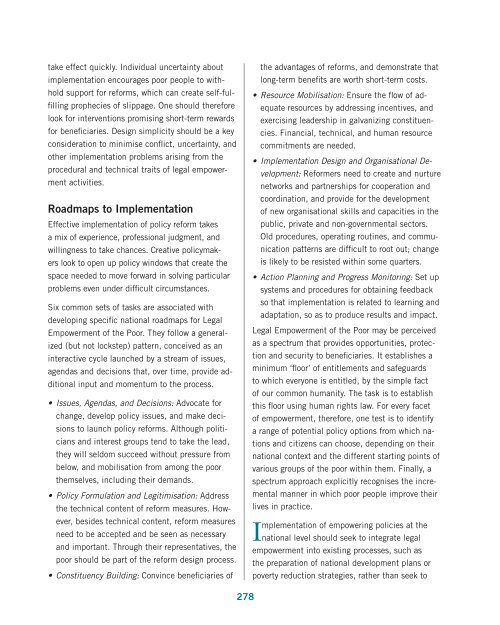Download the file - United Nations Rule of Law
Download the file - United Nations Rule of Law
Download the file - United Nations Rule of Law
You also want an ePaper? Increase the reach of your titles
YUMPU automatically turns print PDFs into web optimized ePapers that Google loves.
take effect quickly. Individual uncertainty aboutimplementation encourages poor people to withholdsupport for reforms, which can create self-fulfillingprophecies <strong>of</strong> slippage. One should <strong>the</strong>reforelook for interventions promising short-term rewardsfor beneficiaries. Design simplicity should be a keyconsideration to minimise conflict, uncertainty, ando<strong>the</strong>r implementation problems arising from <strong>the</strong>procedural and technical traits <strong>of</strong> legal empowermentactivities.Roadmaps to ImplementationEffective implementation <strong>of</strong> policy reform takesa mix <strong>of</strong> experience, pr<strong>of</strong>essional judgment, andwillingness to take chances. Creative policymakerslook to open up policy windows that create <strong>the</strong>space needed to move forward in solving particularproblems even under difficult circumstances.Six common sets <strong>of</strong> tasks are associated withdeveloping specific national roadmaps for LegalEmpowerment <strong>of</strong> <strong>the</strong> Poor. They follow a generalized(but not lockstep) pattern, conceived as aninteractive cycle launched by a stream <strong>of</strong> issues,agendas and decisions that, over time, provide additionalinput and momentum to <strong>the</strong> process.• Issues, Agendas, and Decisions: Advocate forchange, develop policy issues, and make decisionsto launch policy reforms. Although politiciansand interest groups tend to take <strong>the</strong> lead,<strong>the</strong>y will seldom succeed without pressure frombelow, and mobilisation from among <strong>the</strong> poor<strong>the</strong>mselves, including <strong>the</strong>ir demands.• Policy Formulation and Legitimisation: Address<strong>the</strong> technical content <strong>of</strong> reform measures. However,besides technical content, reform measuresneed to be accepted and be seen as necessaryand important. Through <strong>the</strong>ir representatives, <strong>the</strong>poor should be part <strong>of</strong> <strong>the</strong> reform design process.• Constituency Building: Convince beneficiaries <strong>of</strong><strong>the</strong> advantages <strong>of</strong> reforms, and demonstrate thatlong-term benefits are worth short-term costs.• Resource Mobilisation: Ensure <strong>the</strong> flow <strong>of</strong> adequateresources by addressing incentives, andexercising leadership in galvanizing constituencies.Financial, technical, and human resourcecommitments are needed.• Implementation Design and Organisational Development:Reformers need to create and nurturenetworks and partnerships for cooperation andcoordination, and provide for <strong>the</strong> development<strong>of</strong> new organisational skills and capacities in <strong>the</strong>public, private and non-governmental sectors.Old procedures, operating routines, and communicationpatterns are difficult to root out; changeis likely to be resisted within some quarters.• Action Planning and Progress Monitoring: Set upsystems and procedures for obtaining feedbackso that implementation is related to learning andadaptation, so as to produce results and impact.Legal Empowerment <strong>of</strong> <strong>the</strong> Poor may be perceivedas a spectrum that provides opportunities, protectionand security to beneficiaries. It establishes aminimum ‘floor’ <strong>of</strong> entitlements and safeguardsto which everyone is entitled, by <strong>the</strong> simple fact<strong>of</strong> our common humanity. The task is to establishthis floor using human rights law. For every facet<strong>of</strong> empowerment, <strong>the</strong>refore, one test is to identifya range <strong>of</strong> potential policy options from which nationsand citizens can choose, depending on <strong>the</strong>irnational context and <strong>the</strong> different starting points <strong>of</strong>various groups <strong>of</strong> <strong>the</strong> poor within <strong>the</strong>m. Finally, aspectrum approach explicitly recognises <strong>the</strong> incrementalmanner in which poor people improve <strong>the</strong>irlives in practice.Implementation <strong>of</strong> empowering policies at <strong>the</strong>national level should seek to integrate legalempowerment into existing processes, such as<strong>the</strong> preparation <strong>of</strong> national development plans orpoverty reduction strategies, ra<strong>the</strong>r than seek to278
















